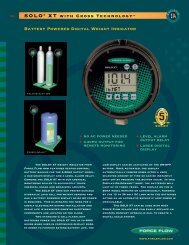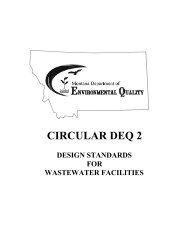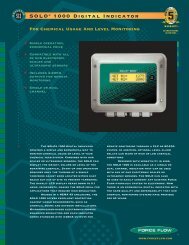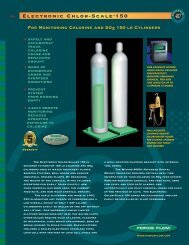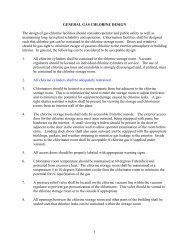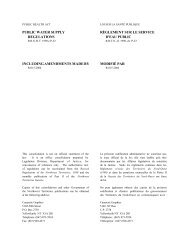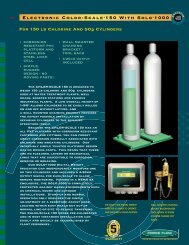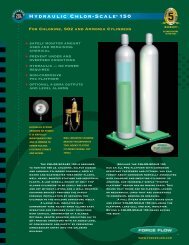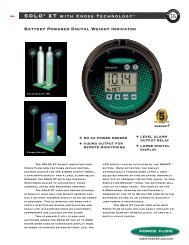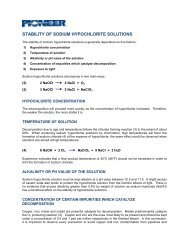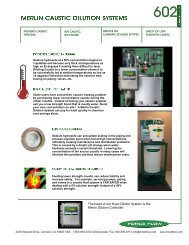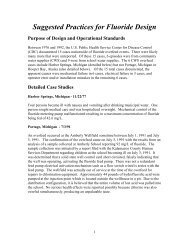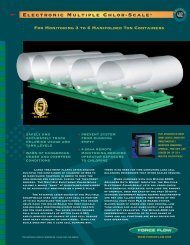Sodium Hypochlorite Handbook - Force Flow
Sodium Hypochlorite Handbook - Force Flow
Sodium Hypochlorite Handbook - Force Flow
You also want an ePaper? Increase the reach of your titles
YUMPU automatically turns print PDFs into web optimized ePapers that Google loves.
One last indication of this problem is the experience of some producers and consumers with PVC ballvalves “exploding” when the valves are closed. This is due to the extremely high pressures createdinside the PVC ball when the heavy metals decompose the bleach. This problem has occurred oftenenough that one PVC ball valve manufacturer is offering a “blowout proof” bleach ball valve. This valvehas a hole drilled on the upstream side of the ball valve. In order to eliminate this potential safetyproblem, simply purchase bleach that has been filtered and contains extremely low levels ofheavy metals.Oxygen formation is virtually eliminated by purchasing high quality sodium hypochlorite with only traceamounts of nickel, copper and suspended solids, and by correct storage and handling of the product.When the sodium hypochlorite is used in the household at typical strengths to 7% by weight, the bleachmust not contain heavy metals since the containers are not vented and any oxygen formation will resultin the storage bottles building excessive oxygen pressure. This problem will result in a product thatcannot safely be sold since the containers may fail during transportation and handling. Thesecontainers can be recognized on the grocery store shelves by the swelling or ballooning of thecontainer.3.0 <strong>Sodium</strong> <strong>Hypochlorite</strong> QualityWhen purchasing sodium hypochlorite the consumer must be concerned with the product quality. Thepurchaser has control of the product quality with respect to bleach strength and quality. By specifying ahigh quality sodium hypochlorite that has only trace amounts of nickel, copper and suspended solids,and correct storage and handling of the product, the following benefits are achieved:• Low chlorate levels in the delivered sodium hypochlorite• Decomposition of the product can be reduced and therefore chlorate formation will be reduced• Settling of the suspended solids will be eliminated in the tanks, pumps, piping and instruments• Negligible amounts of oxygen will be produced• Safety of the piping systems is improved in PVC piping systems by eliminating the source of valveand line ruptures• Existing insoluble compounds coating and plugging feed system will be reabsorbed in the sodiumhypochlorite feed solution and future problems are eliminated.Therefore, the following items must be addressed during the quality testing of the product received.3.1 StrengthThe strength of the sodium hypochlorite is determined by titration. See Section 5.0 References.Since the specified delivered strength of the product can affect chlorate levels, the purchaser mustconsider the strength of the delivered product when specifying the sodium hypochlorite. It is importantfor the purchaser to use a standard nomenclature such as grams per liter available chlorine whenspecifying the strength of the product.3.2 Excess <strong>Sodium</strong> Hydroxide (caustic)The strength of the excess caustic or alkalinity of the solution is determined by titration. See Section5.0 Reference.The minimum amount of excess caustic in normal applications is 0.3 gpl, which is approximately 11.86pH. If the specific gravity of the sodium hypochlorite were 1.20, the 0.3 gpl excess caustic would be0.025% by weight. Any amount of excess caustic below the 11.86% will cause the pH of the solution todrop over time and will result in a much faster rate of decomposition.



